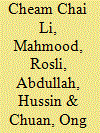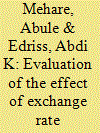|
|
|
Sort Order |
|
|
|
Items / Page
|
|
|
|
|
|
|
| Srl | Item |
| 1 |
ID:
122455


|
|
|
|
|
| Publication |
2013.
|
| Summary/Abstract |
Tourism is one of the largest and fastest growing industries in the world, which makes it a potential strategic factor for economic growth. This adds to the strong interest in the role of tourism in Malaysia's economic growth as it is the second-largest contributor to foreign exchange earnings after manufacturing. In addition, empirical results associated with Granger causality among economic growth, tourism and exports within the neoclassical framework are inconsistent. The objectives of this study, thus, are to determine: the long-run relationship; the long-run and short-run Granger causality; and the long-run triangular Granger causality between economic growth and tourism receipts corresponding to selected macroeconomic variables such as government tourism expenditure, physical capital, education, health and exports as control variables. The long-run Granger causality in vector error correction model (VECM) shows economic growth, tourism receipts and health complement each other (bidirectional causality), while unidirectional causalities are found between government tourism expenditure, physical capital, education and exports to economic growth. In addition, enhancing physical capital, education, health, exports and government tourism expenditure precede tourism receipts; all these in turn indirectly lead to economic growth, thus witnessing triangular relationships among them.
|
|
|
|
|
|
|
|
|
|
|
|
|
|
|
|
| 2 |
ID:
122454


|
|
|
|
|
| Publication |
2013.
|
| Summary/Abstract |
Research was conducted to find out the effects of exchange rate variability, terms of trade, competitiveness and gross domestic product on the dominant export crop of Ethiopia, coffee. This study employs annual time series data (1992-2010) and uses the autoregressive distributive lag (ARDL) model augmented by the Wald test. The results reveal that exchange rate variability has a negative effect on the export of coffee in the short run, but is insignificant in the long run. This implies that, over time, exchange rate changes in the country have been favouring the export performance of coffee. Regardless of exchange rate variability, the competitiveness of the country, explained by real effective exchange rates, improved, but the price of coffee did not increase relative to the price of imports, which has resulted in deteriorating terms of trade. To improve the worsening terms of trade and benefit from policy changes, export diversification and value addition are possible solutions the country should focus on.
|
|
|
|
|
|
|
|
|
|
|
|
|
|
|
|
|
|
|
|
|